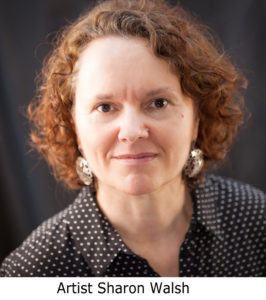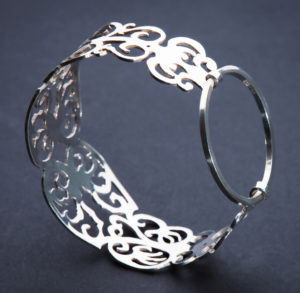A Conversation With an Artist, Part Two
 By B. Kim Barnes, Barnes & Conti CEO
By B. Kim Barnes, Barnes & Conti CEO
This is the continuation of the conversation I had with Sharon Walsh, a jewelry artist from the area around Donegal in Ireland. With the unique challenges we face, artists like Sharon Walsh can help us find own creative and innovative spirit to navigate these difficult times.
In part one, we discussed the link between creativity and curiosity and how they foster both resilience and tenacity in the workplace. We also discussed the use of myth in art, and how myth fosters personal growth as “tools for guidance, for modeling behaviour and for giving meaning to life.”
As most of you know, Barnes & Conti has programs to facilitate creativity and innovation, we are transforming two of them, Applied Creativity and Managing Innovation programs into webinars to meet the moment. Sharon Walsh offers yet more insights, below, in how we can meet the moment, by focusing on the end-user, embracing technology, and confronting often uncomfortable truths.
BKB: How does the nature of your work inform the way you want to conduct your business?
SW: Each piece requires much time and thought…my aim is to design pieces that are beyond fashion or trends, to have jewellery pieces that are timeless and will last forever. An artist does not necessarily need to consider the audience while making an artwork, but a designer must consider the end-user. My…pieces are a combination of art and design processes. The ideas for the jewellery come from my work as an artist, yet the jewellery is designed for people to wear. This emphasis on concept and design takes time, so I am researching various methods of production. Working with social enterprise groups is one option, as are new technologies that complement the hand-made process. A combination of these approaches will allow the business to grow while careful guidance will keep it sustainable. [By selling directly to the customer, I want to allow] space for a conversation between customer and maker.
BKB: What options do you see for creative people whose work is costly? (historic examples; William Morris, Guild of Handicrafts, etc.) to support the social enterprises they want to see succeed?
SW: Creative people can provide community support by working with businesses and social enterprise groups, both locally and further afield. Contributing to local economies by ensuring that skilled craftspeople are fairly treated is important to me. Any engagement with a social enterprise must be of benefit to the community. The Arts & Crafts Movement was set up to ensure that skilled artisans were paid a fair wage for their work. However, the reluctance of the founders to embrace modern methods of production led to the movement’s demise. Being open to technology and how it can be beneficial for business, allowing for growth in a sustainable way, is a valuable consideration.
BKB: What place or function do creativity, artistry, and aesthetics have in times of turmoil and fear?
SW: Art sheds light on our humanity, it is a connection to the past, to the present, to each other. It invites reciprocity: asking us to think, to feel and to grow. Art has the power to change the willing observer, to induce an altered state, often without the use of language. Great art confronts us with truths about ourselves and the world if we are willing to engage in the act of looking – to engage in the challenge laid down by a work of art.
 …Art deals with these issues in a unique way, confronting us with uncomfortable truths that stimulate our senses and our thinking. An artwork [such as the work of Kara Walker or Francisco Goya’s “Disasters of War” or Picasso’s “Guernica” can reveal the horror perpetrated by mankind and engage us in a visceral experience, yet we are removed from the theatre of conflict. If we open up to this exposition, then we can begin to examine the prevailing conventions of our society and to develop a greater understanding of the effects of our actions on others and of what is being done in our name.
…Art deals with these issues in a unique way, confronting us with uncomfortable truths that stimulate our senses and our thinking. An artwork [such as the work of Kara Walker or Francisco Goya’s “Disasters of War” or Picasso’s “Guernica” can reveal the horror perpetrated by mankind and engage us in a visceral experience, yet we are removed from the theatre of conflict. If we open up to this exposition, then we can begin to examine the prevailing conventions of our society and to develop a greater understanding of the effects of our actions on others and of what is being done in our name.
Powerful works of art do not shy away from showing us what a difficult place the world can be. If we engage sincerely with a great work of art, we come away enriched by the experience, with a greater sensitivity to the world and a readiness to reject brutality in any form.
Editor’s note: The photo above is of another one of Sharon Walsh’s creations. You can see more on her website.

Leave a Reply
You must be logged in to post a comment.